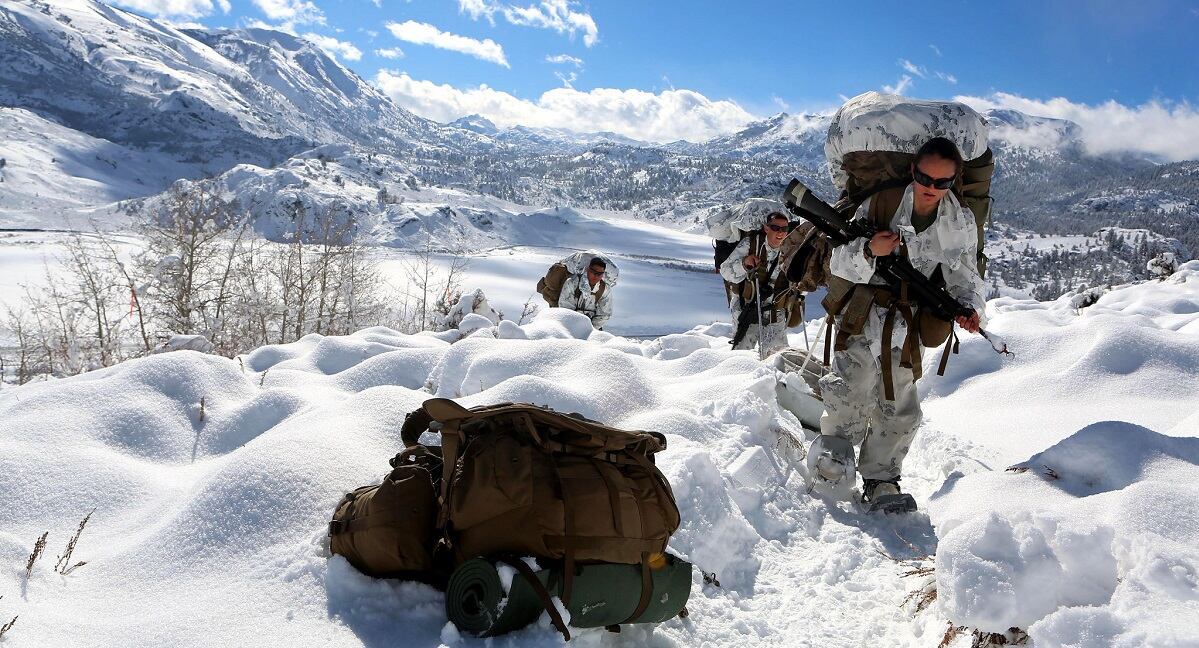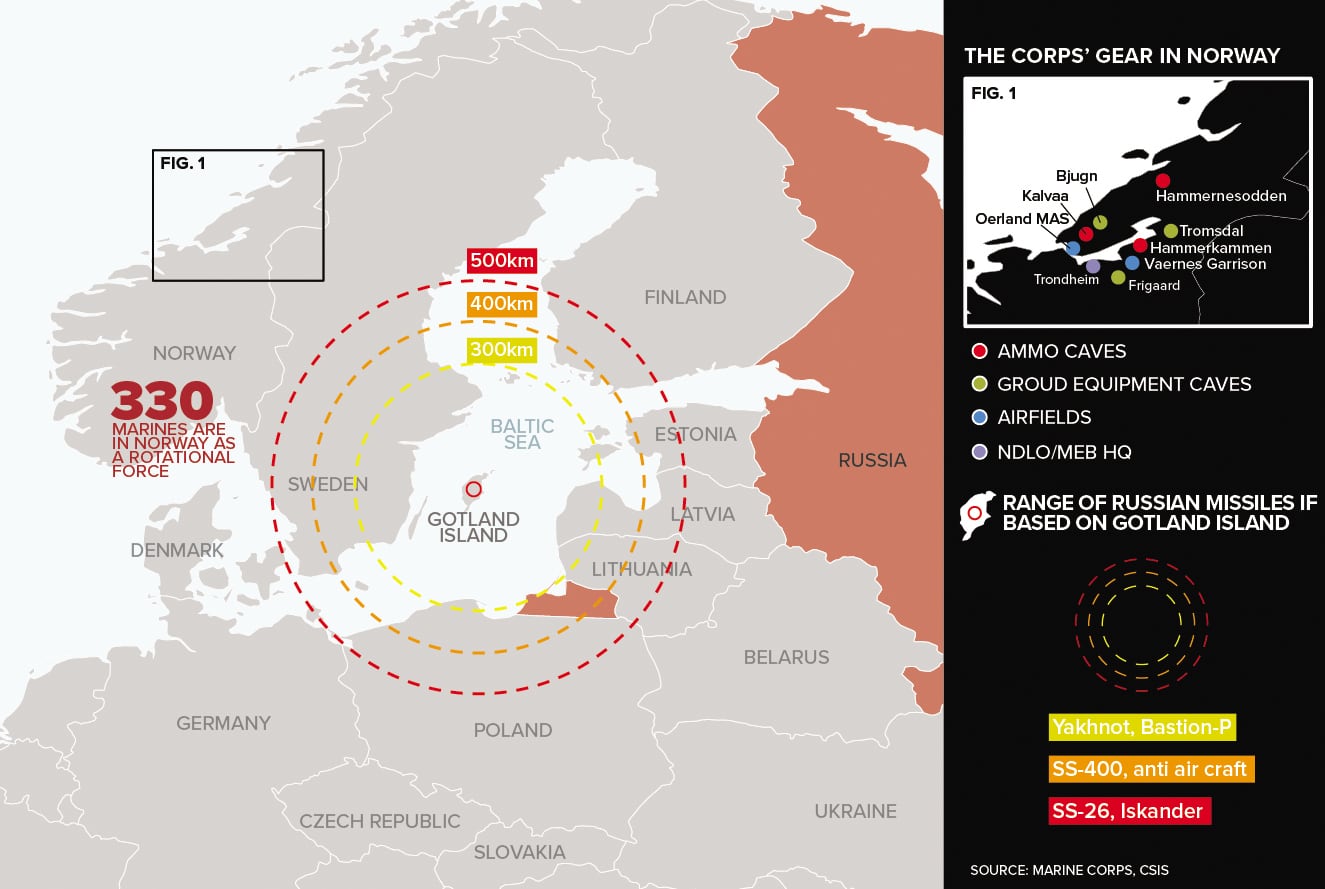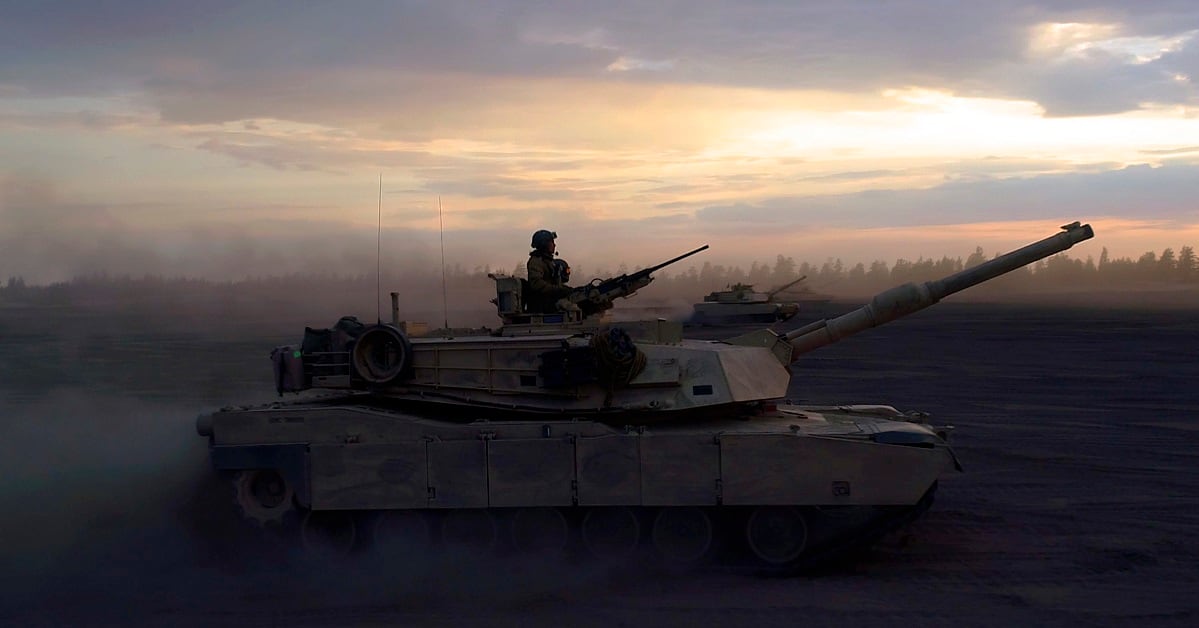A Russian attack on the West would likely come suddenly, with an ambush on the Baltic states by Russian ground forces.
With U.S. and allied forces caught off guard and in a poor position to respond, Russian aircraft and troops would move to secure Sweden’s Gotland Island in the Baltic Sea, which some analysts refer to as an “unsinkable aircraft carrier.”
With NATO’s northern flank under threat, the Russians would quickly move in S-400 surface-to-air defense systems and ballistic missiles onto Gotland Island, which could expand Russian air coverage, and its range for area access and area denial.
Russia would control the Baltic Sea, putting Norway, Sweden and Finland under threat of collapsing.
“In one fell swoop you have sort of proven that NATO does not work,” Magnus Nordenman, director of the Transatlantic Security Initiative, told Marine Corps Times. “American defense guarantees are not worth the paper that it is written on.”
RELATED

This is the nightmare scenario that U.S. military planners, along with European allies, would like to deter. And even though the Marine Corps’ footprint in Europe is small, it may prove pivotal should a fight break out in the Baltics or the high north.
There are only about 2,000 Marines in Europe: 1,000 of those are divided between Spain and Italy as part of the Special-Purpose Marine Air-Ground Task Force-Crisis Response-Africa, about 350 are in Romania, nearly 300 are in Norway and there are about 40 Marines helping train Georgian forces.
Many of those Marines have been prepping for a fight, storing gear in series of caves across of Norway while also participating in training exercises with European and NATO allies across the region.
The program is known as Marine Corps Prepositioning Program-Norway, or MCPP-N, and it is designed to supply an entire Marine Air-Ground Task Force, or potentially a Marine Expeditionary Brigade, or MEB, for 30 days if boosted with extra supplies.
And that’s not the only prepositioning program the Corps has in Europe. The MCPP-N program is also bolstered by Maritime Prepositioning Force, which uses maritime prepositioning ships, or MPSs, to put gear and equipment where it’s needed most.

“Marine Corps Forces Europe and Africa routinely exercise the MPS program to support gear and equipment sets throughout Europe for exercises and Theater Security Cooperation events,” Marine spokesman Lt. Brett Lazaroff told Marine Corps Times.
There are a total of six caves and two storage facilities near airfields in the Troendelag area of central Norway.
The equipment is there to support global operations, yet the Corps routinely pulls gear from those caves to support training exercises across Europe.
The Corps uses ferries and rail to move the equipment across Europe. In fact, the Corps M1A1 Abrams tanks have moved from caves in Norway all the way to Georgia in the Caucasus region by rail.
And just recently, the Corps participated in a Finnish exercise known as Arrow 18, where the Corps brought its Abrams tanks for the first time, moved from caves in Norway. About 30 Marines participated in the large-scale armored and mechanized exercise with roughly 5,000 Finnish soldiers.
The Corps’ focus has primarily been on the Arctic region in the high north, where the Corps is currently on its third rotation in Norway undergoing extreme cold weather training not far from the Russian border.
And last September the Corps participated in Sweden’s largest exercise in 20 years: Aurora 17.
The high north countries of Norway, Sweden and Finland are separate from the Baltic region, but they are strategically linked.
“If there is a crisis between Russia and the Baltic states, that crisis would then quickly move into the high north, NATO’s northern flank,” Nordenman said.
A conflict with Russia is likely to start in the Baltic, not the high north, according to Nordenman.
Because of geography and size, “they are some of the most exposed allies NATO currently has.”
The popular consensus in Washington is that once Russian forces roll though Poland and the Baltic States of Estonia, Lithuania and Latvia, they’ll target Gotland.
“Gotland is essentially an unsinkable aircraft carrier in the middle of the Baltic Sea,” Nordenman said.

Taking the island would extend the Russian area access and area denial bubble beyond what is already covered by its missile forces stationed in Kaliningrad.
“It would make it difficult for NATO and the United States to respond,” Nordenman said.
And the Corps is certainly worried about this.
Marines were training on Gotland as part of Exercise Aurora with Sweden in September 2017.
The Russians’ intent of taking Gotland and emplacing ballistic missile systems or air defense would be to extend coverage for Russian aircraft and bombers.
“The first would be the SS-26 SRBM [short range ballistic missile] and/or R-500 ground-launched cruise missile for land-attack. Although redundant with their capabilities in Russia proper and Kaliningrad, it would give them another axis of attack against NATO forces in or moving into the Baltic states,” said Ian Williams, the associate director of the Missile Defense Project at Center for Strategic and International Studies.
“Increasing the number of attack axes complicates Patriot air defenses which still use 120-degree sectored radars,” he said, referring to the U.S. weapons system.
Russia would need air defense systems and anti-ship systems as well to keep NATO and allied forces at bay.
“It is likely that Russia would also want to emplace coastal defense anti-ship missiles like the Yakhont (Bastion-P) systems, as it has in Kaliningrad.” Williams said. “This would help it control the seaways and littoral areas in that part of the Baltic, and the accompanying radar systems would give it better situational awareness as well.”
Russia would likely start installing BUK 3 air defense systems early on and “if it had time and breathing room it might follow up with a longer-range system like S-300 or S-400. These take more time to get into operation, as compared to the BUK-types which are shoot-and-scoots,” Williams explained.
A Russian BUK missile is allegedly responsible for the downing of Malaysian Airlines Flight 17 over Ukraine, which killed all 298 passengers on July 17, 2014.
However, Nordenman is not convinced Gotland is as important as everyone is making it out to be.
“It would be very risky for the Russians,” to leave the cover of their air defense system to reach Gotland, Nordenman said. “I think they have a decent A2/AD [area access/area denial] bubble out of Kaliningrad already.”
“You go to Gotland, what then? You’re sort of stuck there,” he said.
So how does the Corps play into this scenario?
The Baltic states have a small deterrence force mainly comprised of U.S. Army soldiers. But high-ranking officials are considering a new concept “a rapid and effective reinforcement of the Baltic states to either enhance deterrence or to defend them in a fight,” Nordenman explained, saying the Corps could play a role in that reinforcement.
In June, the Corps sent a large contingent to participate in exercise Saber Strike 18, which kicked off June 3 and was slated to run till June 15.
Saber Strike is U.S. Army-led training exercise that takes place in Latvia, Lithuania, Estonia and Poland, and this year approximately 1,100 Marines from 4th Marine Logistics Group, 4th Marine Division and the Black Sea Rotational Force participated. It was the Corps’ largest participation in an exercise in the region this year.
Another important contribution the Corps brings to a fight in the Baltics or the high north, its amphibious capabilities.
The Corps has practiced amphib landings in Sweden, Poland and the Baltic states, Nordenman said.
And the Corps routinely participates in BALTOPS, a multinational maritime exercise in the Baltic Sea.
BALTOPS 18 kicked off June 3, focusing this year on anti-submarine warfare, countermine warfare, air defense and amphibious operations. The exercise will also see an amphib landing at Ustka, Poland, with Assault Amphibious Vehicles, landing craft air cushion vehicles and Polish landing ships.
The potential is there for NATO, European allies, and the U.S. to work together on amphibious operations but “it hasn’t been stitched together at the strategic level,” he said.
Shawn Snow is the senior reporter for Marine Corps Times and a Marine Corps veteran.





